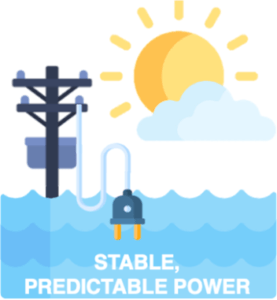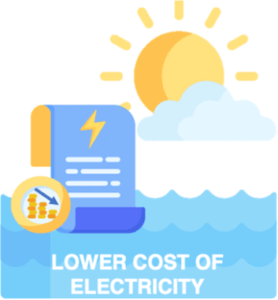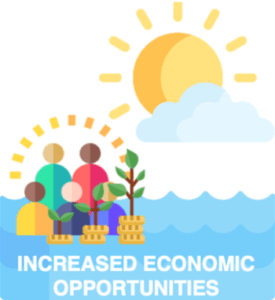How It Works
Wave Energy Conversion
Wave energy, or wave power, converts the kinetic energy of ocean waves into electricity. Devices called wave energy converters, or WECs, capture the kinetic energy of the waves’ motion and use it to drive a generator that converts the kinetic energy into electrical energy.
Waves are abundant, powerful, and predictable. They swell and wane, but never cease. This means wave power parks can operate 24/7, providing a significant amount of baseload power. Estimates place wave’s theoretical energy production at 29,500 TWh per year, approximately 125% of the electrical energy consumed around the globe.
Wave Power Parks: Providing SIDS with Stable, Predictable Energy
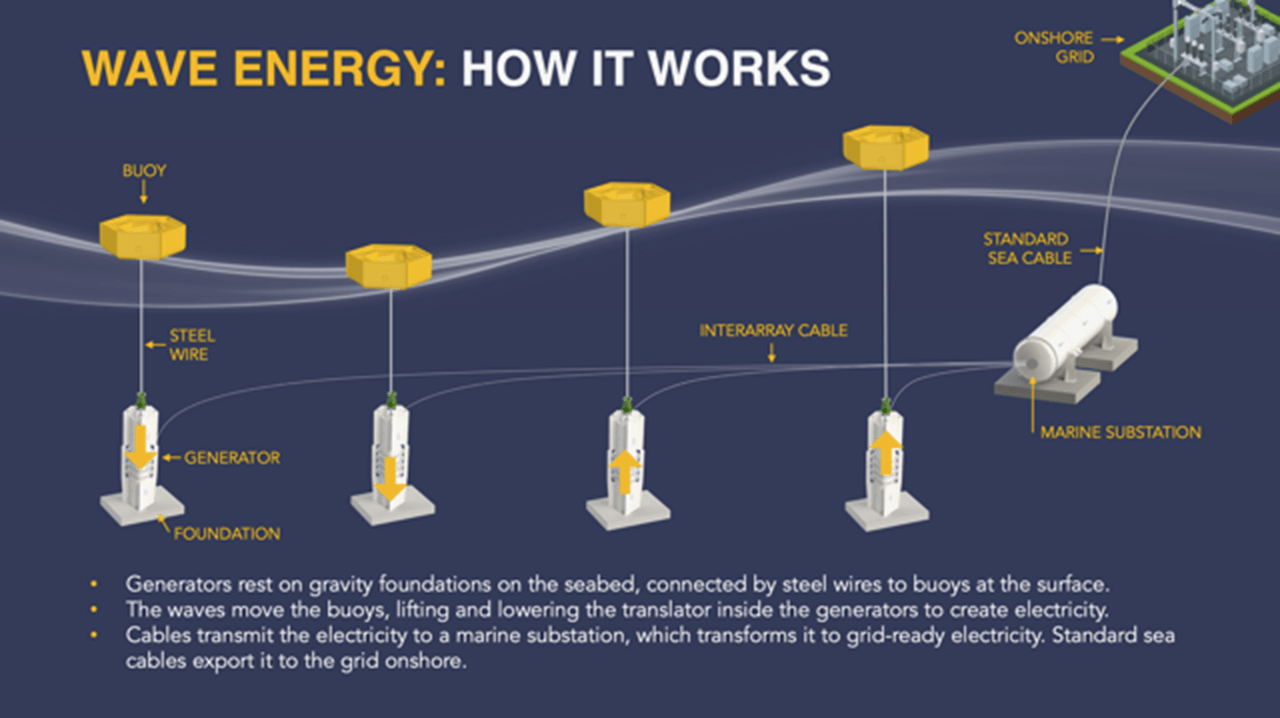
Wave Energy Technology
Wave energy, or wave power, harnesses the energy of ocean waves and converts it into usable forms of energy, such as electricity. The technologies used for wave energy conversion vary, but all use devices called wave energy converters, or WECs, that capture the kinetic energy of the motion of the waves and convert it into electrical energy.
As the demand for renewable energy sources increases, there is growing interest in wave energy. The various maturing technologies are finding more cost-effective and efficient designs that can withstand often harsh ocean conditions.
In contrast to wind and solar, wave energy devices are not standardized in appearance. Rather, different solutions are under development, and they are suited to different environments. Some are designed to capture the energy nearshore, or even where the sea meets the coast, while others are designed to be further out, either in arrays or as single units powering an offshore device. Some are designed to provide small amounts of power at remote locations, whereas others, like the point absorber technology pictured above, are more suitable for utility-scale use, such as projects in Bermuda and Tonga.
Benefits of Wave Energy
In addition to being a CO2-free, renewable source of electricity, there are benefits to including wave energy in the portfolio of energy technologies well-suited for SIDS. Wave power can lead to decarbonization with the added benefits of stable power, lower cost of electricity, increased economic opportunities, and enhanced energy security.
Stable, Predictable Power 
Ocean waves are a constant and renewable resource, a trait that is highly valuable to the electricity grid. When the wind dies down, a cloud blocks the sun, or the sun sets, the power supply is cut off quite quickly, sometimes without warning.
Waves work differently. Water is dense and heavy compared to air. While a cubic meter of air weighs just over 1kg, a cubic meter of water weighs about 1,000kg, or about as much as a baby humpback whale. It takes longer to get moving, and longer to slow so the change in the amount of power it provides is more gradual. This is good news for grid operators because it means they can know how much wave power they will have several days, or even weeks, in advance. In many locations, much of the power supplied by waves is so stable and predictable it can be considered baseload power.
Lower Cost of Electricity
Exorbitant electricity prices are the bane of many SIDS. Fortunately, there are a growing number of wave energy projects that show promise to reduce the cost of electricity, including in Bermuda and Tonga. These projects will provide much-needed relief to end users, while simultaneously reducing the outflow of foreign currency to purchase fossil fuels.
Increased Economic Opportunities 
Wave energy can provide SIDS with opportunities to develop a local skilled workforce, enable social inclusion, and promote science, technology, and innovation. It creates new local jobs in the manufacturing, installation, operation, and maintenance of wave power parks.
It is also well-adapted to SIDS’ constraints. As it is based at sea, it requires minimal land area, a commodity that is scarce and highly valued. It also has low visual impact; wave parks are typically invisible at even a short distance. Tourism is a primary source of income for many SIDS, and gorgeous views of both land and sea have an economic value, in addition to the value they have for the local population and the environment.
Most islanders live near the coast, and waves can provide a renewable that’s generated close to where it is used, minimizing the cost of grid upgrades and reducing power leakage along long transmission routes.
Enhanced Energy Security
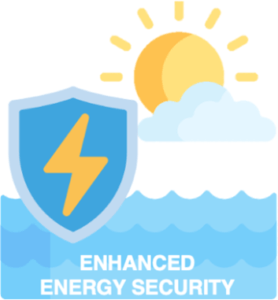
Using ever-present wave power can significantly reduce the need for costly imported fuels and free up valuable financial resources. The transition to wave power both enhances energy security and places SIDS on a sustainable, resilient path toward a more prosperous future.
Challenges Facing Wave Energy
As with any emerging industry, wave energy faces obstacles it must overcome on its trajectory toward becoming the next mainstream renewable to power homes on SIDS and elsewhere around the world. It must find ways to tackle technical, socio-environmental, infrastructure, and planning & regulatory challenges.
Technological
Wave energy is on the cusp of commercialization. Much progress has been made in recent decades, resulting in improvements to reliability and performance and attracting financial support. With prudence, SIDS can prioritize technologies and projects that best fit their needs, in a context that minimizes risk.
Infrastructural
The small size and/or instability of local power grids can hinder any new energy project, including wave. Fortunately, since waves can provide a certain amount of baseload, it can be easier to integrate on the grid than more intermittent renewables. Wave energy can help SIDS achieve its goals of balanced and resilient power grids.
Planning and Regulatory
Wave power remains absent from most Marine Spatial Plans and Integrated Resource Plans. Furthermore, the requirements for permits and consents, as well as access support schemes, can be disadvantageous for innovative technologies such as wave.
The Government of Bermuda has found several ways to mitigate this for its planned wave park. For example, they have created a regulatory “sandbox” to introduce new energy technologies while minimizing risk. Additionally, they have implemented a ‘one-stop-shop’ approach, where communication with all authorities is routed through one key governmental contact.
The Future of Wave Energy
Wave has the potential to provide SIDS, and coastal areas around the world, with a significant source of renewable energy that can also provide baseload power, bring down energy costs, and increase energy security. While challenges are still to be addressed, wave energy can play an essential role in the transition to more sustainable, low-carbon energy systems in the SIDS.
References
The Government of Bermuda. (23 May, 2023). New Legislative Amendments Pave the Way for Energy Regulatory Sandbox. Retrieved from https://www.gov.bm/articles/new-legislative-amendments-pave-way-energy-regulatory-sandbox
Hertz-Shargel, B. (2021). Ensuring Energy Security in a Renewables World. The Atlantic Council. https://www.atlanticcouncil.org/wp-content/uploads/2021/03/AC_ENERGY_v9_FINAL.pdf
IEA. (2020). Innovation Outlook: Ocean Energy Technologies. Retrieved from https://www.irena.org/Publications/2020/Dec/Innovation-Outlook-Ocean-Energy-Technologies
IEA.(2023). Electricity Information Overview. Retrieved 10 October 2023 from https://www.iea.org/reports/electricity-information-overview/electricity-consumption
IRENA. (2020). Fostering a Blue Economy: Offshore Renewable Energy. Retrieved from https://www.irena.org/-/media/Files/IRENA/Agency/Publication/2020/Dec/IRENA_Fostering_Blue_Economy_2020.pdf
Jeffrey, H., De Roeck, Y., Brito e Melo, A. (2020). Ocean Energy in Islands and Remote Coastal Areas. OES. Retrieved from https://www.ocean-energy-systems.org/publications/oes-documents/market-policy-/document/ocean-energy-in-islands-and-remote-coastal-areas-2020-/
Ono, R. (2022, Aug 23). What Is Wave Energy? Ocean Conservancy. https://oceanconservancy.org/blog/2022/08/23/wave-energy/
Renewable Energy Magazine (20 March 2023). The Kingdom of Tonga Chooses Seabased Wave. Retrieved from https://www.renewableenergymagazine.com/ocean_energy/the-kingdom-of-tonga-chooses-seabased-wave-20230320
The Royal Gazette. (2021). Wave Power Could Be Answer To Electricity Needs As Pilot Scheme Considered. Retrieved from https://www.royalgazette.com/environment/news/article/20211122/wave-power-could-be-answer-to-electricity-needs-as-pilot-scheme-considered/
The Island Promise
In 1799 French engineer Pierre Girard was granted a patent on the use of energy from ocean waves. In 1910 French engineer M. Bochaux-Praceique generated electricity from sea waves. Yoshio Masuda, “the father of modern WEC” developed a navigation buoy powered by wave energy.
Wave power utilizes a resource that is abundant for islands, rather than requiring scarce land area. Its predictability and stability are well-suited for the needs of smaller grids, and it can relieve islands from the enormous expense of, and often corresponding foreign debt from, importing fossil fuels.
The assembly, installation, monitoring, and maintenance of wave parks bring with them skilled local jobs and economic opportunities for island communities.
Bender, A., Langhamer, O., Sundberg, J.(2020)
Colonization of Wave Power Foundations by Mobile Mega- and Macrofauna – a 12-Year Study. Marine Environmental Research, vol. 161, Oct. 2020, p. 105053, https://doi.org/10.1016/j.marenvres.2020.105053
Jeffrey, H., De Roeck, Y., Brito e Melo, A. (2020)
Ocean Energy in Islands and Remote Coastal Areas: Opportunities and
Challenges. IEA Technology Collaboration Programme for Ocean Energy Systems,
2018, www.ocean-energy-systems.org/documents/85277-ocean-energy-in-islands-and-remote-coastal-areas.pdf/

FAQ
What is Wave Energy?
Wave energy, or wave power, harnesses the kinetic energy of ocean waves and converts it into usable forms of energy, such as electricity. The technologies used for wave energy conversion can vary, but all involve using devices called wave energy converters, or WECs, that capture the power of the motion of the waves and convert it into electrical energy.
How does Wave Energy work?
Wave energy harnesses the kinetic energy of ocean waves and converts it into usable forms of energy, such as electricity. The process is done by a Wave Energy Converter or WEC and typically involves the following steps:
- Capturing the Energy: The first step is to capture the energy of the waves. This is done in various ways, such as with a buoy or other floating device designed to move in response to the motion of the waves.
- Converting the Energy: Once the wave energy has been captured, it must be converted into a usable form of energy. This is typically done through the generator or other type of electrical device part of the WEC, that converts the mechanical energy of the waves into electrical energy.
- Transmitting the Energy: Once the WEC has converted the energy into electricity, is the electricity then transmitted to the grid or to a battery storage system, where it can be used to power homes, businesses, or other electrical loads.
What are the advantages of Wave Energy?
There are several advantages of wave energy, including:
- Renewable: One of the primary advantages of wave energy is that it is a renewable source of energy. Waves are generated by the sun and the wind, which means that wave energy is essentially an indirect form of solar and wind energy. As long as there is sun and wind, waves will continue to be generated, making wave energy a renewable and sustainable source of energy.
- Predictable: Unlike other forms of renewable energy, such as wind or solar, waves are highly predictable and reliable. They are slow to build and slow to wane, so they are an excellent source of stable power. Wave patterns can be forecast days and even weeks in advance, making it easier for grid operators to integrate wave power into their energy mix. That allows them to meet higher targets of renewable energy in the power they provide.
- High Energy Density: Waves have a high energy density, meaning that there is a lot of energy contained within a relatively small area. This makes wave energy a highly efficient form of renewable energy.
- Low Environmental Impact: Wave energy systems have a relatively low environmental impact compared to other forms of energy generation. Unlike fossil fuels, which produce greenhouse gas emissions and other pollutants, wave energy produces no emissions or waste products.
- Location Flexibility: Wave energy systems can be installed in a wide range of locations, including offshore and near-shore environments. This makes it possible to generate energy in areas where other forms of energy generation may not be feasible.
Overall, wave energy has the potential to be a significant source of clean and renewable energy, with several advantages over other forms of energy generation. However, there are still technical and economic challenges that must be addressed before wave energy can be widely deployed.
How old is Wave Energy Technology?
Because waves are an abundant and highly predictable energy source, the concept of harnessing the energy of ocean waves has been around for centuries. The first patent for a wave energy device was filed in 1799 by French engineer and mathematician, Pierre-Simon Girard. However, it wasn’t until the 20th century that significant progress was made in developing practical WEC systems.
One of the first practical WEC devices was the Salter Duck, invented by Scottish engineer Stephen Salter in the 1970s. The Salter Duck was a point-absorber device that used a floating buoy to capture the energy of the waves and convert it into electricity.

Are there different types of Wave Energy technologies?
Yes, several wave energy technologies have been developed, each with its unique design and method of operation. Some common types of wave energy technologies are explained below:
- Point Absorbers involve buoys at or near the ocean´s surface connected to a fixed structure placed on, or anchored to, the seabed. The force of the wave motion drives a generator to produce electricity.
- Overtopping Devices are structures built onshore or on offshore platforms. As waves pass over the structure, they fill a reservoir with water, which is then released through a turbine to generate electricity.
- Oscillating Water Columns use a partially submerged chamber open to the ocean. As waves enter the chamber, they compress the air inside, which drives a turbine to generate electricity.
- Surface Attenuators can consist of multiple connected segments or one long, flexible section. They are placed parallel to incoming waves to capture the energy of the flexing motion resulting from the swells’ rise and fall.
- Oscillating Wave Surge Converters use the waves’ horizontal, back-and-forth surge movement to capture energy in an oscillating arm.



